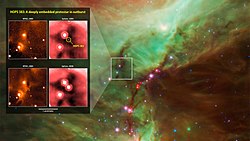HOPS 383
Appearance

| Observation data Epoch J2000.0 Equinox J2000.0 | |
|---|---|
| Constellation | Orion |
| Right ascension | 5h 35m 29.81s |
| Declination | −4° 59′ 51.1″ |
| Distance | 1,400 ly ly (420 pc) |
| Spectral type | Class 0 protostar |
| Other designations | |
HOPS 383 | |
HOPS 383 is a Class 0 protostar. It is the first class-0 protostar discovered to have had an outburst,[1] and as of 2015, the youngest protostar known to have had an outburst.[1] The protostar was discovered by the Herschel Orion Protostar Survey (HOPS) team.[2]
References
- ^ a b "NASA satellites catch 'growth spurt' from newborn protostar". Science Daily. 24 March 2015.
- ^ "NRL Astrophysicist Explores Star Formation in Orion's Belt". U.S. Department of Defense. 6 March 2015.
Further reading
- "HOPS 383: An Outbursting Class 0 Protostar in Orion"; Emily J. Safron, William J. Fischer, S. Thomas Megeath, Elise Furlan, Amelia M. Stutz, Thomas Stanke, Nicolas Billot, Luisa M. Rebull, John J. Tobin, Babar Ali, Lori E. Allen, Joseph Booker, Dan M. Watson, T. L. Wilson; The Astrophysical Journal Letters, Volume 800, Issue 1, article id. L5, 6 pp. (2015) February 2015; arXiv:1501.00492; Bibcode:2015ApJ...800L...5S; doi:10.1088/2041-8205/800/1/L5;
